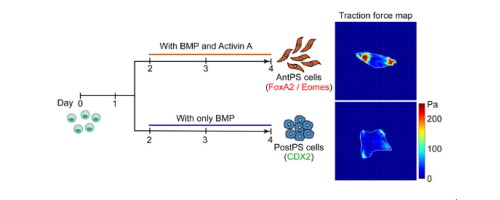Acta Biomaterialia ( IF 9.4 ) Pub Date : 2019-01-11 , DOI: 10.1016/j.actbio.2019.01.017
Feng Lin , Yue Shao , Xufeng Xue , Yi Zheng , Zida Li , Chunyang Xiong , Jianping Fu

|
Formation of the primitive streak (PS) marks one of the most important developmental milestones in embryonic development. However, our understanding of cellular mechanism(s) underlying cell fate diversification along the anterior-posterior axis of the PS remains incomplete. Furthermore, difference in biophysical phenotypes between anterior and posterior PS cells, which could affect their functions and regulate their fate decisions, remain uncharacterized. Herein, anterior and posterior PS cells were derived using human pluripotent stem cell (hPSC)-based in vitro culture systems. We observed that anterior and posterior PS cells displayed significantly different biophysical phenotypes, including cell morphology, migration, and traction force generation, which was further regulated by different levels of Activin A- and BMP4-mediated developmental signaling. Our data further suggested that intracellular cytoskeletal contraction could mediate anterior and posterior PS differentiation and phenotypic bifurcation through its effect on Activin A- and BMP4-mediated intracellular signaling events. Together, our data provide new information about biophysical phenotypes of anterior and posterior PS cells and reveal an important role of intracellular cytoskeletal contractility in regulating anterior and posterior PS differentiation of hPSCs.
Statement of Significance
Formation of the primitive streak (PS) marks one of the most important developmental milestones in embryonic development. However, molecular and cellular mechanism(s) underlying functional diversification of embryonic cells along the anterior-posterior axis of the PS remains incompletely understood. This work describes the first study to characterize the biophysical properties of anterior and posterior PS cells derived from human pluripotent stem cells (hPSCs). Importantly, our data showing the important role of cytoskeleton contraction in controlling anterior vs. posterior PS cell phenotypic switch (through its effect on intracellular Smad signaling activities downstream of Activin A and BMP4) should shed new light on biomechanical regulations of the development and anterior-posterior patterning of the PS. Our work will contribute significantly to uncovering new biophysical principles and cellular mechanisms driving cell lineage diversification and patterning during the PS formation.
中文翻译:

人多能干细胞衍生的前原始和后原始条纹细胞的生物物理表型和决定因素
原始条纹(PS)的形成是胚胎发育中最重要的发展里程碑之一。然而,我们对沿PS前后轴的细胞命运多样化所依据的细胞机制的理解仍然不完整。此外,前PS细胞和后PS细胞之间的生物物理表型差异可能会影响其功能并调节其命运决定,目前尚无定论。在此,使用基于人类多能干细胞(hPSC)的体外来源获得前后PS细胞文化系统。我们观察到,前后PS细胞显示出明显不同的生物物理表型,包括细胞形态,迁移和牵引力生成,而这又受不同水平的激活素A和BMP4介导的发育信号的调节。我们的数据进一步表明,细胞内细胞骨架收缩可以通过其对激活素A和BMP4介导的细胞内信号转导事件的影响来介导PS的前后分化和表型分叉。在一起,我们的数据提供有关前和后PS细胞的生物物理表型的新信息,并揭示细胞内细胞骨架收缩在调节hPSC的前和后PS分化中的重要作用。
重要声明
原始条纹(PS)的形成是胚胎发育中最重要的发展里程碑之一。但是,沿PS前后轴方向的胚胎细胞功能多样化的分子和细胞机制尚不完全清楚。这项工作描述了第一个表征人多能干细胞(hPSC)的前后PS细胞的生物物理特性的研究。重要的是,我们的数据显示了细胞骨架收缩在控制前部和后部PS细胞表型转换中的重要作用(通过其对激活素A和BMP4下游的细胞内Smad信号转导作用的影响),应为发育和前体的生物力学调控提供新的思路。 PS的后部图案。

































 京公网安备 11010802027423号
京公网安备 11010802027423号